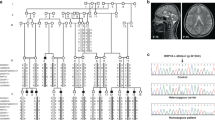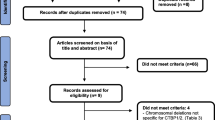Abstract
The mutation of human cereblon gene (CRBN) is revealed to be related with mild mental retardation. Since the molecular characteristics of CRBN have not been well presented, we investigated the general properties of CRBN. We analyzed its gene structure and protein homologues. The CRBN protein might belong to a family of adenosine triphosphate (ATP)-dependent Lon protease. We also found that CRBN was widely expressed in different tissues, and the expression level in testis is significantly higher than other tissues. This may suggested it could play some important roles in several other tissues besides brain. Transient transfection experiment in AD 293 cell lines suggested that both CRBN and CRBN mutant (nucleotide position 1,274(C > T)) are located in the whole cells. This may suggest new functions of CRBN in cell nucleolus besides its mitochondria protease activity in cytoplasm.



Similar content being viewed by others
Abbreviations
- ARNSMR:
-
Autosomal recessive non-syndromic mental retardation
- BKCa :
-
Large-conductance Ca2+-activated K+
- CRBN:
-
Cereblon
- MR:
-
Mental retardation
- rCRBN:
-
Rat cereblon
References
Curry CJ, Stevenson RE, Aughton D et al (1997) Evaluation of mental retardation: recommendations of a Consensus Conference: American College of Medical Genetics. Am J Med Genet 72:468–477
Wright SW, Tarjan G, Eyer L (1959) Investigation of families with two or more mentally defective siblings; clinical observations. Am J Dis Child 97: 445–463
Matsuura T, Sutcliffe JS, Fang P et al (1997) De novo truncating mutations in E6-AP ubiquitin-protein ligase gene (UBE3A) in Angelman syndrome. Nat Genet 15:74–77
Albrecht U, Sutcliffe JS, Cattanach BM et al (1997) Imprinted expression of the murine Angelman syndrome gene, Ube3a, in hippocampal and Purkinje neurons. Nat Genet 17:75–78
Costa RM, Federov NB, Kogan JH et al (2002) Mechanism for the learning deficits in a mouse model of neurofibromatosis type 1. Nature 415:526–530
Xing J, Ginty DD, Greenberg ME (1996) Coupling of the RAS-MAPK pathway to gene activation by RSK2, a growth factor-regulated CREB kinase. Science 273:959–963
Galdzicki Z, Siarey R, Pearce R et al (2001) On the cause of mental retardation in Down syndrome: extrapolation from full and segmental trisomy 16 mouse models. Brain Res Rev 35:115–145
Shahbazian M, Young J, Yuva-Paylor L et al (2002) Mice with truncated MeCP2 recapitulate many Rett syndrome features and display hyperacetylation of histone H3. Neuron 35:243–254
Petrij F, Giles RH, Dauwerse HG et al (1995) Rubinstein–Taybi syndrome caused by mutations in the transcriptional co-activator CBP. Nature 376:348–351
Wang YH, Amirhaeri S, Kang S et al (1994) Preferential nucleosome assembly at DNA triplet repeats from the myotonic dystrophy gene. Science 265:669–671
Darnell JC, Jensen KB, Jin P et al (2001) Fragile X mental retardation protein targets G quartet mRNAs important for neuronal function. Cell 107:489–499
Yang EJ, Yoon JH, Min do S et al (2004) LIM kinase 1 activates cAMP-responsive element-binding protein during the neuronal differentiation of immortalized hippocampal progenitor cells. J Biol Chem 279:8903–8910
Joseph JH, Joanna P, Roni QL et al (2004) A mutation in a novel ATP-dependent Lon protease gene in a kindred with mild mental retardation. Neurology 63:1921–1931
Charriaut-Marlangue C, Otani S, Creuzet C et al (1991) Rapid activation of hippocampal casein kinase II during long-term potentiation. Proc Natl Acad Sci USA 88:10232–10236
Maurizi MR, Trisler P, Gottesman S (1985) Insertional mutagenesis of the lon gene in Escherichia coli: lon is dispensable. J Bacteriol 164:1124–1135
Goff SA, Goldberg AL (1987) An increased content of protease La, the lon gene product, increases protein degradation and blocks growth in Escherichia coli. J Biol Chem 262:4508–4515
Sooyeon J, Kwang-Hee L, Sungmin S et al (2005) Identification and functional characterization of cereblon as a binding protein for large-conductance calcium-activated potassium channel in rat brain. J Neuro chem 94:1212–1224
Lu B, Liu T, Crosby JA et al (2003) The ATP-dependent Lon protease of Mus musculus is a DNA-binding protein that is functionally conserved between yeast and mammals. Gene 306:45–55
Wang N, Gottesman S, Willingham MC et al (1993) A human mitochondrial ATPdependent protease that is highly homologous to bacterial Lon protease. Proc Natl Acad Sci USA 90:11247–11251
Basel-Vanagaite L, Alkelai A, Straussberg R et al (2003) Mapping of a new locus for autosomal recessive non-syndromic mental retardation in the chromosomal region 19p13.12-p13.2: further genetic heterogeneity. J Med Genet 40:729–732
Acknowledgements
This work was supported by the National Science Foundation of Shanghai (No.04ZR14040).
Author information
Authors and Affiliations
Corresponding author
Additional information
Wang Xin and Ni Xiaohua contributed equally to this article.
Rights and permissions
About this article
Cite this article
Xin, W., Xiaohua, N., Peilin, C. et al. Primary function analysis of human mental retardation related gene CRBN . Mol Biol Rep 35, 251–256 (2008). https://doi.org/10.1007/s11033-007-9077-3
Received:
Accepted:
Published:
Issue Date:
DOI: https://doi.org/10.1007/s11033-007-9077-3




